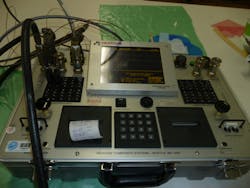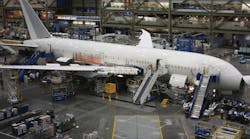The ABC's of Composite Repair
In selecting a title for this article, I wanted to convey the perception that composite repair is not that difficult, or at least no more difficult than sheet metal repair. To be certain, it requires training, practice, and experience to become truly proficient at producing well-crafted airworthy composite repairs, but then so too does sheet metal repair. The main difference is that composite repair technology most likely represents a new set of skills, processes, and materials to which most technicians have not been exposed.
Should you make the effort to acquire these skills? I will let you be the judge of that, but consider the following; Boeing, Airbus, Gulfstream, Pilatus, Hawker Beechcraft, Dassault, Bombardier, Cessna, Leer, Diamond, Cirrus, (to name a few) all rely on composite materials in primary structural applications. In a paper written by the National Institute of Aviation Research, it is projected that the use of composites in aircraft construction will quadruple over the next 20 years.
This rapid growth in aerospace composites will not be without problems. There is and will continue to be a gap between the manufacturers' (OEMs) development and production of these aircraft and the maintenance industry’s ability to maintain them. This gap has two aspects: numbers and technology. There are simply not enough technicians trained and experienced in composite inspection and repair to meet the anticipated needs. New inspection and repair technology skills will need to be acquired by maintenance organizations and personnel. Compounding these issues is the fact that there is very little standardization of repair processes among the manufacturers. To overcome this gap, many OEMs have developed and offer training specific to their types.
While this may satisfy the needs of the OEMs, it does not lead to any standardization of the composite repair process. But upon closer examination, we can place the OEM processes within the framework of a series of sequential tasks, recognizing that each OEM may utilize different procedures for completing the task. I have identified the following tasks in outlining a standard composite repair;
Inspection/damage assessment. Each OEM provides an inspection and damage assessment criteria in their publications. For the most part, they are consistent on inspection criteria; visual inspection of the structures followed by a detailed inspection of known or suspected damaged. On glass fiber structure this may involve paint removal (glass fiber reveals damage well visually), tap testing, or NDT inspections. Known or suspected damage to carbon fiber structures usually requires NDT inspection.
Determine repair authority. What is damaged, where it is damaged, and how large is the damage are all criterion manufacturers use when providing standard repair data in their publications. You will find much variation among them. Some are very generous and some are very restrictive in what repairs the publications authorize, but in all cases, there is a point in which you must contact their engineering department for repair support. You need to know where that point is.
Obtain repair data and materials. Whether you are using standard repair data from the AMM/SRM (Structural Repair Manual) or an OEM engineered repair, you need to fully understand the repair before proceeding. I refer to this as “Getting your head around the repair.” If you do not “see” the finished repair, call the OEM help line for assistance. Use only OEM approved materials within shelf life limits for accomplishing the repair.
Removal of paint and damaged material. While it may be necessary to remove paint for assessment purposes, you will now need to remove enough paint to accommodate the repair. I am aware of no OEM which allows the use of chemical strippers for paint removal. Repair data will tell you how much damaged material to remove, but generally less is better.
Preparation of laminate surface. With most OEMs, there are two aspects to this task. The mechanical abrasion of the repair area creates a heightened level of molecular activity on the laminate surface, ensuring a stronger chemical bond with the repair materials. The second aspect is the scarfing or stepping down of the damaged laminate to the full depth of damage. This not only effectively reduces the height of the repair, but ensures a better interface between the repair materials and the damaged laminate. Each OEM has their preference here, but both require high levels of technician tool skill and practice.
Preparation of repair materials. This task contains several processes which will vary among the OEMs.
1. The OEM will specify wet lay or pre-preg materials. With pre-preg, the resin has been incorporated into the fabric and dried and requires a bonding machine for curing. Consult the AMM/SRM for the list of approved materials.
2. The number of repair plies specified is generally a function of the number of damaged plies.
3. The repair ply overlap is how much larger or smaller each ply must be relative to the damage and the previous ply.
4. When the fabric is woven, the dominant yarns, called warp, run in one direction and are crossed by lesser fill yarns. The OEM designers specify which direction the warp fibers must run relative to the structure. This is referred to as ply orientation (0-, +45-, -45-, and 90-degree orientations are typical).
5. Some OEMs require plies be stacked from smallest to largest, while others require the opposite stack.
6. If the repair requires replacement of damaged core material, consult the AMM/SRM for approved core type and thickness (as well as ribbon direction if honeycomb).
Laminating. Most OEMs have restrictive laminating environmental conditions in regards to airborne contaminants and temperature/humidity limitations. OEM publications will include information on correct resin to fabric ratio and avoiding entrapped air (porosity) in the lamination. While these conditions are easiest to maintain by applying the lamination one ply at a time, the repair location may dictate that you pre-stack the plies and apply the lamination as one unit (to maintain ply overlap and orientation).
Curing. Pre-preg repairs require a schedule of vacuum bagging materials as well as a bonding machine. While you can use this equipment on wet lay repairs, due to their expensive nature, many OEMs allow less expensive and less complex curing options. Heat sources may include heat lamps, heat guns, or hair driers so long as cure temperature is monitored and controlled (recording cure data is also a good practice). The actual cure parameters are more a function of the resin manufacturer than the aircraft OEM and include minimum/maximum temperature and time requirements as well as temperature ramp rates and scheduled hold periods or dwells.
Inspection. Some of the criteria set forth by the OEMs include inspecting the repair for proper curing of the resin, complete bonding between the repair and the structure, voids or porosity in the repair, and evidence of correct resin content.
While organizing OEM procedures into a set of related tasks may help in developing a sense of a standard composite repair process, it must be emphasized that strict adherence to the individual OEM approved data, materials, and processes is imperative. If, for example, you find you prefer the method of stacking plies that OEM A uses more than that of OEM B, you must use OEM B’s method when repairing an OEM B aircraft. There is no substitution of material or procedure allowed without OEM approval.
Like them or not, composites have earned a place in modern aircraft design and chances are you may end up in a position where you will be faced with the prospect of inspecting or repairing them. Will you be ready?
Tim Wright has been working with aerospace composites for 16 years as a technician and technical trainer. As a technical instructor for Cirrus Aircraft in Duluth, MN, Tim Wright trained more than 250 technicians, engineers, A&P instructors and regulatory agents on Cirrus Aircraft composite damage assessment and repair processes. Most recently, he has developed and launched aerospace composite programs at Northland Community and Technical College in Thief River Falls, MN, and Wisconsin Indianhead Technical College in Superior, WI. He is currently on the faculty of Wisconsin Indianhead Technical College.


